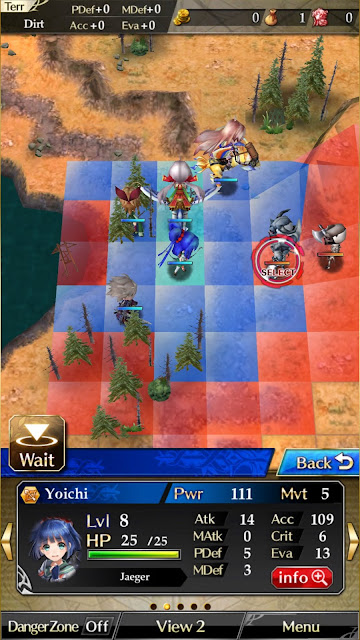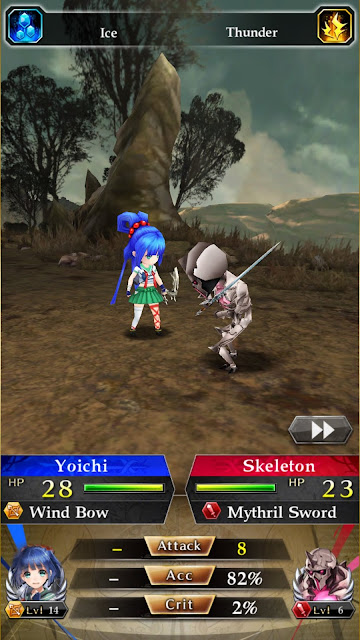Review by Matt S.
It looks like the turn based tactical RPG genre is a good fit with the free-to-play monetisation model. Phantom of the Kill, which plays out very much like a Fire Emblem title does, offers a near endless wealth of content, and marries it with tight and engaging turn based JRPG mechanics to produce not only one of the best free-to-play games that we’ve come across so far, but one of the better examples of the genre, period.
Related reading: gumi also localised Chain Chronicle. Now, sadly, dead, it was a great game while it lasted. Matt’s full review.
The plot, which includes some great anime cut scenes to help set the tone and draw players in, centres around an apocalypse, in which a demon army has successfully invaded the world, driving humanity to the brink of annihilation. The remnants fight back, using ancient weapons that they’ve managed to turn into animate beings, and who have the power and capacity to hurt the demons. It’s a fairly simple plot, to be sure, and nothing we haven’t seen in one form or another in anime before. It’s also a little muddled in places, and it’s difficult to tell whether that’s a consequence of the writing, or the English location, but ultimately the plot does what it needs to do in order to set an effective scene for the combat to play out.
The free-to-play elements come in how you recruit new soldiers to your side. There are a couple of different forms of currency in Phantom of the Kill, and two of them are used primarily to recruit new units. The currency earned in-game from standard battles will recruit the standard-quality units, while the rare and powerful heroes are obtained with the premium currency, which is either earned in scarce quantities from combat, or can be purchased using real currency. Those rare characters aren’t actually essential to working through the game, though they speed the process up, and often you’ll want to unlock them any way for the simple reason that they look so cool.
When I play tactics strategy games I inevitably fall into the same patterns where I’ll develop favourite characters, and I’ll figure out how to get through the levels using those, even when characters I don’t like would be more useful or powerful. I’ve done some crazy things in the past, like run with multiple archers in Fire Emblem games, to going all-out with the Moogles in the Final Fantasy tactics games. Moogles are cool, kupo.
Phantom of the Kill makes it easier to play silly games with party composition, because there are more really powerful, really attractive characters to play with, but yes, I am in that same habit in that I’m running with characters that I like on an aesthetic level more than a practical one. In this case it means I’ve got multiple all-girl teams, and as many of them are mounted as possible. The range of character types is impressive, though there’s a lot of doubling up of character types – for example, there was a very definite reason to have both axes and swords in your Fire Emblem team, but the difference between having those in Phantom of the Kill are less pronounced, and the impact of having characters poorly matched with their enemies less extreme.
On the plus side that meant I could include my gorgeous axe-wielding girl on the back of a chocobo-like giant bird in the same group of five as my equally gorgeous sword-wielding girl on the back of a pegasus-like thing. You can have teams of up to five characters in Phantom of the Kill, as well as one “bonus” character that you can borrow from someone’s online party, and there are no real restrictions on how you build the teams. It’s also possible to run with multiple different teams, so you can seamlessly try different combinations from one level to the next.
While individual characters don’t have a great deal of personality in terms of explicit plot development, they do enjoy strong personalities thanks to the absolutely incredible art designs that they have for their profiles. The designs fit with fairly standard anime tropes, of course, but they are a good mix of fun, sexy, elegant and flat-out beautiful that will mean most fans of JRPGs will find their ideal mix. In game the 3D models are fairly blocky and not always great representations of the profile images, but they’re adequate enough that you’ll still feel ownership over the units nonetheless.
At the start of the game battles are short, intense battles in which your team of five will take on a handful of enemies, but the adventure progresses, the scale slowly grows, and enemies become more difficult both in numbers and individual power. This being a free-to-play game there is, of course, a degree of grinding you’ll have to go through, but between the main story missions, regular rotating “event” battles and individual character’s story battles, there’s more than enough ways to do that grinding that it never feels much like a chore.
The game also puts limits on how long you can play through its AP bar, which reduces with every battle. I’ve seen games that are far more restrictive with how they chew up similar “stamina” bars, and Phantom of the Kill can be played for fairly lengthy periods before needing to take a break, so while I continue to question the overall wisdom of actually stopping people from playing when the goal of a free-to-play game is to have people playing for as long as possible, as often as possible, I also see this AP bar useful in forcing players to take a break. In practice, that AP bar is probably helping me from hitting a wall in the game where the grind becomes too much.
There’s also a full equipment system, and naturally you can fuse characters and items together to try and make them more powerful. There’s a lot of grinding involved here, too, but there’s also a nice thrill in seeing a party that was struggling a few battles previous now trouncing the enemy.
But the real appeal of this game is that it’s a functionally endless take on Fire Emblem. Units move around in the same was as that game, and battle maps have the same kind of features. Because the content just keeps on flowing there’s such a friendly grind about the whole experience that tactics RPG veterans will be in seventh heaven. It’s the kind of game you’re not going to mind throwing a few dollars at, because it feels and behaves very much like a premium game anyway.
gumi’s picked a real winner to localise in Phantom of the Kill. The tactical turn based action lends itself well to the free-to-play strengths, in collecting characters and then grinding them up to become powerful. Set against the quality, albeit generic story background, what we’ve got here is a full-featured and lengthy tactics RPG to make those train trips that much more bearable. Hopefully the game proves a success in English so that gumi can continue to support it with content, updates, and special events and characters to earn.
– Matt S.
Editor-in-Chief
Find me on Twitter: @digitallydownld











